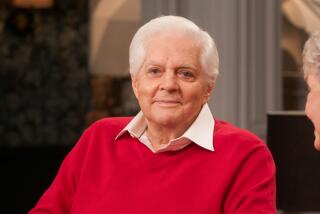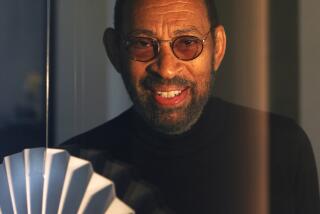Yep, He Was Out Before Ellen
- Share via
In 1933, in a Great Depression-wracked country turning increasingly conservative, MGM head Louis Mayer issued an ultimatum to fading star Billy Haines. The star’s reply, more than half a century before Ellen DeGeneres came out, undoubtedly caught him by surprise.
“I’ll be glad to give up my boyfriend,” Haines shouted. “As soon as you get rid of your wife.”
To this day, Haines is thought to be Hollywood’s only openly gay film star ever, says Bill Horn, spokesman for the Gay and Lesbian Alliance Against Defamation. And now, his life and times are resurrected in “Wisecracker” (Viking), by Massachusetts journalist William J. Mann.
“Billy lived his life with complete integrity,” Mann said. “It’s always hard to do that, but even harder in the ‘30s in [Hollywood], because he was under such pressure to conform.”
Born in Stanton, Va., Haines ran off to New York when he was 16, where he parlayed his good looks into a career as a gigolo. “In the ‘20s, thewar to end all wars--World War I--had ended,” Mann said. “It was a time of political radicalism, of free thinking and free love. The rules of the past had broken down, and new rules were still being written. Definitions between homosexual and heterosexual were fluid, and eyebrows weren’t raised if two people cohabited outside of marriage.”
Even in this heady atmosphere, however, Haines’ excesses got him into trouble. Kept by “many of the best men and women in the city,” Haines ultimately jeopardized his life as the kept boyfriend of a Fifth Avenue matron by inviting his friends to come over and party--without her. In 1921, the woman walked in on one of his impromptu parties and kicked him out.
This might have marked the end of Haines’ meteoric rise through society, but soon after, he won a Goldwyn studios contest seeking out fresh faces. The following spring, he was on a train to Hollywood, a studio contract under his arm. Haines proved a quick study, and starred in more than a dozen films between 1926 and 1930. His breakthrough role was in “Brown of Harvard,” a sentimental story of two college roommates. His biggest film was “Tell It to the Marines.”
Haines starred in the era’s silent movies, but his “big, booming voice” easily enabled him to make the transition to the talkies, Mann said. Haines’ house on Stanley Drive became “one of the places to be invited to. Invitations to his parties were among the most coveted in Hollywood.”
The times were different then, too, with many fashionable clubs frequented by both gays and straights. And so Haines accompanied stars such as Joan Crawford and then producer Howard Hughes to drag queen contests and the like--with both the contests and who attended reported on by the Hollywood Reporter.
During a trip back to New York, Haines also met former Navy man Jimmie Shields. Shields was considerably wilder, and he soon moved in with Haines. True, Haines also had affairs with women, but he kept them to himself for to publicize them, he believed, would have betrayed Shields, his one true love.
As Haines’ career was hitting its peak, however, the Depression abruptly set in. Haines’ sexually ambiguous singing and dancing were no longer in demand. During harder times, Americans preferred their stars to be unambiguous men of few words, leaving Haines with ever smaller roles amid increasing rumors about his personal life, Mann said.
Then, he turned down Mayer’s ultimatum. “His career ended when he didn’t want to play the game,” Mann said.
Haines and Shields would spend 40 more years together, Haines becoming an interior decorator whose friends included Nancy Reagan and whose commissions included the American Embassy in London. Adamantly nonpolitical, Haines died in 1973, four years after the Stonewall riots in New York.
So, why this book now? Haines’ is “an absolutely extraordinary story, unknown by most people,” said Viking Editor Ed Iwanicki. “He was the No. 1 star in Hollywood, a real pioneer. And we expect an inordinate interest in his career and the times in which he lived.”
Concluded Mann, about his volume, written in conversational tones: “I’ve been a movie fan since age 5. I always knew who Billy Haines was. This book is my way to remind others of him.”


